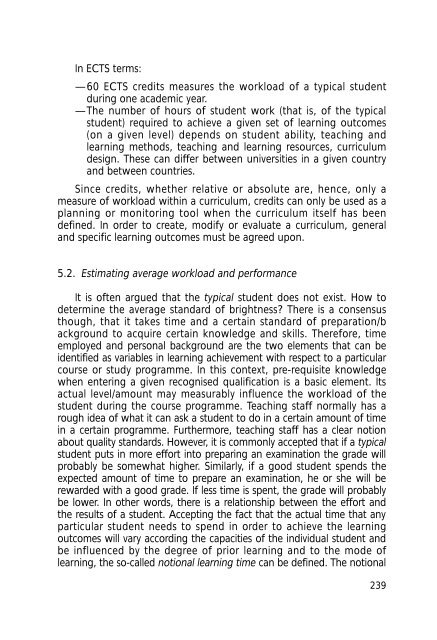Final Report Pilot Project - Relaciones Internacionales de la ...
Final Report Pilot Project - Relaciones Internacionales de la ...
Final Report Pilot Project - Relaciones Internacionales de la ...
Create successful ePaper yourself
Turn your PDF publications into a flip-book with our unique Google optimized e-Paper software.
In ECTS terms:<br />
—60 ECTS credits measures the workload of a typical stu<strong>de</strong>nt<br />
during one aca<strong>de</strong>mic year.<br />
—The number of hours of stu<strong>de</strong>nt work (that is, of the typical<br />
stu<strong>de</strong>nt) required to achieve a given set of learning outcomes<br />
(on a given level) <strong>de</strong>pends on stu<strong>de</strong>nt ability, teaching and<br />
learning methods, teaching and learning resources, curriculum<br />
<strong>de</strong>sign. These can differ between universities in a given country<br />
and between countries.<br />
Since credits, whether re<strong>la</strong>tive or absolute are, hence, only a<br />
measure of workload within a curriculum, credits can only be used as a<br />
p<strong>la</strong>nning or monitoring tool when the curriculum itself has been<br />
<strong>de</strong>fined. In or<strong>de</strong>r to create, modify or evaluate a curriculum, general<br />
and specific learning outcomes must be agreed upon.<br />
5.2. Estimating average workload and performance<br />
It is often argued that the typical stu<strong>de</strong>nt does not exist. How to<br />
<strong>de</strong>termine the average standard of brightness? There is a consensus<br />
though, that it takes time and a certain standard of preparation/b<br />
ackground to acquire certain knowledge and skills. Therefore, time<br />
employed and personal background are the two elements that can be<br />
i<strong>de</strong>ntified as variables in learning achievement with respect to a particu<strong>la</strong>r<br />
course or study programme. In this context, pre-requisite knowledge<br />
when entering a given recognised qualification is a basic element. Its<br />
actual level/amount may measurably influence the workload of the<br />
stu<strong>de</strong>nt during the course programme. Teaching staff normally has a<br />
rough i<strong>de</strong>a of what it can ask a stu<strong>de</strong>nt to do in a certain amount of time<br />
in a certain programme. Furthermore, teaching staff has a clear notion<br />
about quality standards. However, it is commonly accepted that if a typical<br />
stu<strong>de</strong>nt puts in more effort into preparing an examination the gra<strong>de</strong> will<br />
probably be somewhat higher. Simi<strong>la</strong>rly, if a good stu<strong>de</strong>nt spends the<br />
expected amount of time to prepare an examination, he or she will be<br />
rewar<strong>de</strong>d with a good gra<strong>de</strong>. If less time is spent, the gra<strong>de</strong> will probably<br />
be lower. In other words, there is a re<strong>la</strong>tionship between the effort and<br />
the results of a stu<strong>de</strong>nt. Accepting the fact that the actual time that any<br />
particu<strong>la</strong>r stu<strong>de</strong>nt needs to spend in or<strong>de</strong>r to achieve the learning<br />
outcomes will vary according the capacities of the individual stu<strong>de</strong>nt and<br />
be influenced by the <strong>de</strong>gree of prior learning and to the mo<strong>de</strong> of<br />
learning, the so-called notional learning time can be <strong>de</strong>fined. The notional<br />
239


